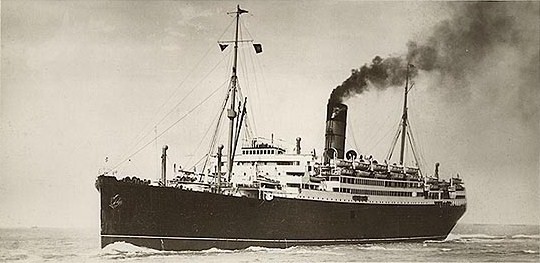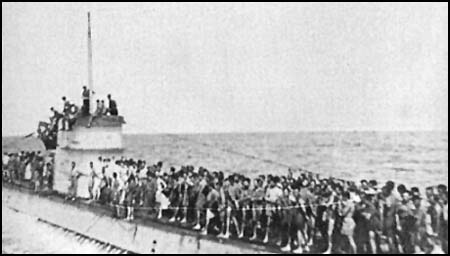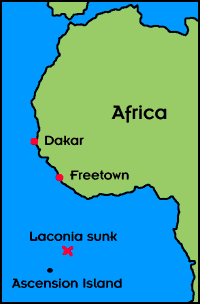The Laconia Incident
by Gudmundur Helgason

The liner Laconia
On Sept 12, 1942 at 2207 hours U-156 under the command of Kptlt. Werner Hartenstein torpedoed a large target in the South Atlantic in position 05.05S, 11.38W. The large vessel was the British liner Laconia (19,695 tons) which sank at 2323 hours. The liner was carrying a 136-man crew, some 80 civilians, military material and personnel (268 men) and approx. 1800 Italian prisoners of war with 160 Polish soldiers on guard.
Radio message from Laconia (sent on Sept 12, 2222 hours on 600 meters-frequency)
Shortly after the sinking the crew of U-156 was amazed to hear Italian voices in the sea amongst the people
both in lifeboats and also struggling in the water itself. Hartenstein immediately began rescue operations and radioed
for assistance, both from nearby U-boats and also sent out un coded messages to every vessel around to assist,
promising to cease hostilities.
Radio message from U-156 to BdU (Sent on Sept 13, 0125 hours):
Versenkt von Hartenstein Brite "Laconia". Marinequadrat FF 7721 310 Grad. Leider mit 1500 italienischen Kriegsgefangenen. Bisher 90 gefischt. 157 cbm. 19 Aale, Passat 3, erbitte Befehle.
Translation
Sunk by Hartenstein British "Laconia". Grid FF 7721 310 degrees. Unfortunately with 1,500 Italian POW's. Till now 90 fished. 157 cubic meters (oil). 19 eels (torpedoes), trade wind, ask for orders.
Uncoded message
(sent on Sept 13, 0600 hours on 25 meters-frequency) :
If any ship will assist the ship-wrecked 'Laconia'-crew, I will not attack providing I am not being attacked by ship or air forces. I picked up 193 men. 4, 53 South, 11, 26 West. - German submarine.

Hartenstein's U 156 loaded with Laconia survivors
 In the next days U-156 saved some 400 survivors, hold 200 on board and the other
200 in lifeboats. On Sept 15, at 1130 hours U-506 under Kptlt Erich Würdemann
arrived at the scene and continued to rescue the survivors. A few hours later
U-507 under Korvkpt. Harro Schacht and the Italian submarine Cappellini also
arrived. The boats headed for shore, towing the lifeboats behind them and hundreds of survivors
were both in and inside the U-boats themselves.
In the next days U-156 saved some 400 survivors, hold 200 on board and the other
200 in lifeboats. On Sept 15, at 1130 hours U-506 under Kptlt Erich Würdemann
arrived at the scene and continued to rescue the survivors. A few hours later
U-507 under Korvkpt. Harro Schacht and the Italian submarine Cappellini also
arrived. The boats headed for shore, towing the lifeboats behind them and hundreds of survivors
were both in and inside the U-boats themselves.
On Sept 16, at 1125 hours an American B-24 Liberator bomber operating from the Ascension Island arrived at the scene where its pilot spotted the boats (which at that time flew the Red Cross flag and were clearly not hostile to anyone). The pilot radioed back to his base asking for instructions and was told to attack at once which he did at 1232 hours, forcing the U-boats to cut the lines to the life boats and submerge immediately, leaving hundreds of people again struggling in the water.
Thankfully this US intervention caused not as much loss of life as it could have as shortly afterwards some neutral French warships from Dakar arrived at the scene and started picking up survivors. Also many had been taken into the U-boats themselves and were safe there (only because the bomber failed to sink them though). Roughly 1500 survived the sinking.
This incident prompted one of the most controversial order Dönitz ever issued, usually known as the Laconia order today, it made it absolutely clear that no U-boats were to take part in any rescue operations from that date and leave any survivors in the sea. Up until that time U-boats had on very many occasions helped the survivors of their victims with supplies, water, directions to nearest land and so on.
Laconia-Befehl (Laconia order)
- Jegliche Rettungsversuche von Angehörigen versenkter Schiffe, also auch das Auffischen Schwimmender und Anbordgabe auf Rettungs- boote, Aufrichten gekenterter Rettungsboote, Abgabe von Nahrungsmitteln und Wasser haben zu unterbleiben. Rettung widerspricht den primitivsten Forderungen der Kriegsführung nach Vernichtung feindlicher Schiffe und deren Besatzungen.
- Die Befehle über das Mitbringen von Kapitänen und Chefingenieuren bleiben bestehen.
- Schiffbrüchige nur dann retten, wenn ihre Aussagen für das Boot von Wichtigkeit sind.
- Bleibt hart. Denkt daran, das der Gegner bei seinen Bombenangriffen auf deutsche Städte keine Rücksicht auf Frauen und Kinder nimmt!
Translation
- Every attempt to save survivors of sunken ships, also the fishing up of swimming men and putting them on board lifeboats, the setup right of overturned lifeboats, the handing over of food and water have be discontinued. These rescues contradict the primitive demands of warfare esp. the destruction of enemy ships and their crews.
- The orders concerning the bringing in of skippers and chief engineers stay in effect.
- Survivors are only to rescue, if their statements are important for the boat.
- Stay hard. Don't forget, that the enemy didn't take any regard for woman and children when bombarding German towns.
This order was used as an excuse for the controversial conviction of Dönitz for war
crimes at Nüremberg in 1946. Most sensible people agree that the German U-boats fought
hard but fair considering the situation and the US submarine force fought with the same
aggressiveness against japanese shipping (and if anything the US subs were more unforgiving).
Thus many say that Dönitz was simply punished for being too efficient at his job and his
U-boats having been to much of a threat to allied shipping and the outcome of the war.
Dönitz served 11 years and 6 months in prison.
This article was published on 13 Apr 1997.
Buy this title at amazon.co.uk |
Books dealing with this subject include
|


